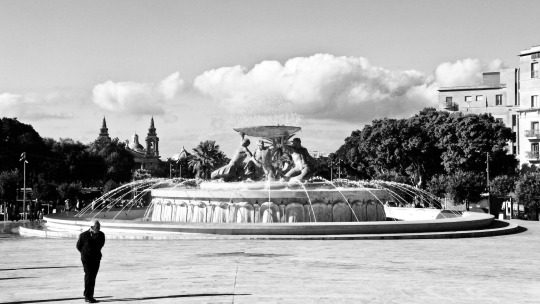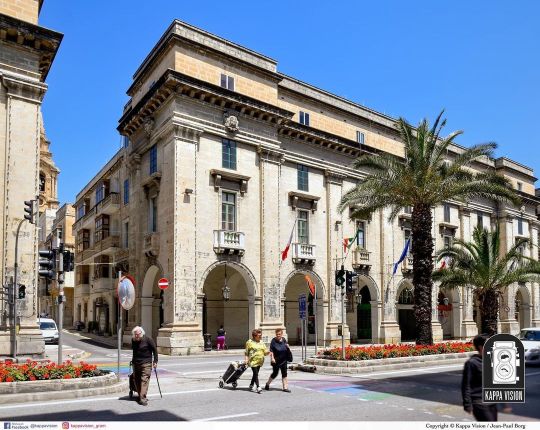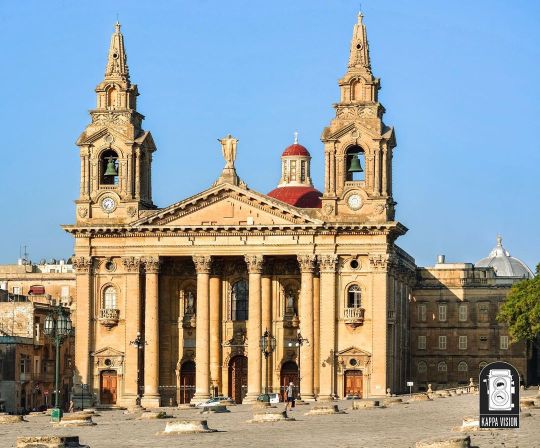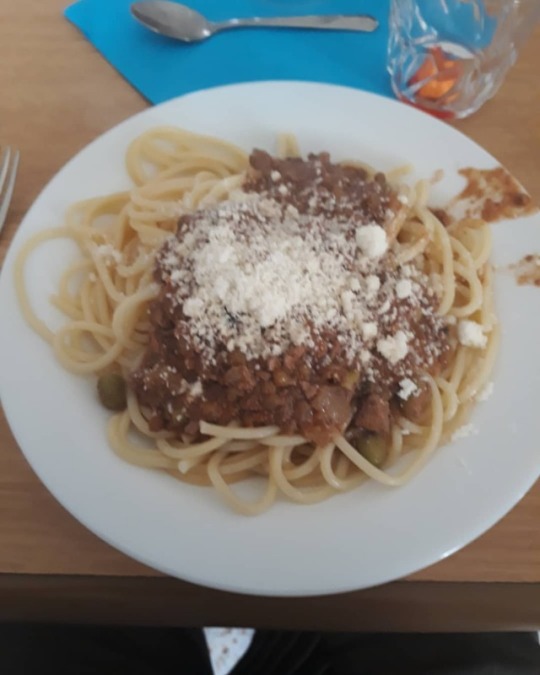#il-furjana
Text

La Fontaine (Il-Furjana, Malte)
#il-furjana#floriana#malte#malta#people#people of the world#travel#voyage#street#rue#photography#street photography#travel photography#photographie#photographie de rue#photographie de voyage#travel europe#voyage en europe#noir et blanc#black and white#photographers on tumblr
2 notes
·
View notes
Photo

The landmark buildings alongside the thoroughfare to Valletta. This is St. Anne Street in Floriana, Malta. Bil-Malti: Triq Sant’Anna il-Furjana. THE ARCADES - IL-LOĠOĠ The walk-ways along the sides of Floriana's St. Anne Street are distinguied by shady, covered arches which have characterised the city’s most famous street for many years. Commonly know as ‘loġoġ’ in Maltese, the arcades accommodate a number of shops, cafés, offices and other commercial outlets. DID YOU KNOW? St. Anne Street remains Floriana’s main street and its most famous one. It is the main thoroughfare to Malta’s capital city Valletta - and the only street in Malta built in Neo-Classical style. The Lion Fountain, standing proud in the middle of this busy road, has been guarding the town since 1728. SHOULD IT BE CHANGED INTO A PUBLIC GARDEN? St. Anne Street has been at the centre of recent debate as to whether or not it should be converted into a car-free, eco-friendly green pedestrian zone. The ‘greening’ of St. Anne Street would see it changed into a large public garden that would follow the lead of other major cities around Europe like Paris. (at Floriana, Malta) https://www.instagram.com/p/CeDSYhmOpW_/?igshid=NGJjMDIxMWI=
0 notes
Photo

Part 2 😛 (at Il-Furjana, Malta) https://www.instagram.com/p/BvY8cPuH2wU/?utm_source=ig_tumblr_share&igshid=faelbk2j5hjm
0 notes
Text
L-Ingliżi f'Malta fis-seklu 19.
L-Ingliżi f’Malta fis-seklu 19.
Mal-iffirmar tal-kapitulazzjoni tal-Franċiżi, fil-5 ta’ Settembru tal-1800, bejn il-Ġeneral Pigot u l-Kaptan George Martin, għan-naħa tal-Ingliżi, u l-Ġeneral Vaubois u l-Ammiral Villeneuve, għan-naħa tal-Franċiżi, il-bandiera Ingliża ttelgħet fuq Bieb il-Bombi, il-Furjana.
Il-mexxejja Maltin li kienu ħaduha kontra l-Franċiżi waqt l-Imblokk, xtaqu li l-Ingliżi jibqgħu hawn għaliex dawn…
View On WordPress
0 notes
Text
Hotels Malta cat
Booking.com
Ciutats de Malta a
Attard
b
Baħar iċ-Ċagħaq
Balzan
Birbuba
Birgu
Birkirkara
Birżebbuġa
Buġibba
c
Comino
Cospicua
d
Dingli
f
Fgura
g
Għajn Klieb
Għajn Melel
Għajnsielem
Għarb
Għargħur
Għasri
Għaxaq
h
Ħal Far
Ħal Mula i
Iklin
Il- Gżira
Il-Furjana
Il-Gżira
Il-Maħsel
Il-Pergla
Il-Qortin taʼ Għajn Żejtuna
Il-Wilġa
In-Naħħalija
Is-Swieqi
Iż-Żlielaq
k
Kalafrana
Kalkara
Kerċem
Kirkop
l
La Valletta
Lija
Luqa
m
Mani…
View On WordPress
0 notes
Photo

The Church of St Publius, Il-Furjana.
16 notes
·
View notes
Photo

After an absence of two years due to the restrictions, the feast of St. Publius will be celebrated again in Floriana on Sunday May 1st. This year’s feast coincides with a tragic bombing of the parish church of Floriana 80 years ago - a deliberate attack that inflicted considerable damage to the church’s structure, forever destroyed many art pieces and valuable sacred objects, and, above all, left thirteen people dead. Il-Knisja Arcipretali ta’ San Publiju fil-Furjana. A CHURCH RISING FROM THE FAMOUS GRANARIES The majestic parish church serving the town of Floriana rises from the vast, paved expanse known as the granaries (pictured in the foreground). The ‘fosos’, as they are known in Maltese, are subterranean grain silos punctuated by large, flat, stone caps marking the top of each one. The granaries were excavated during the rule of the Knights of St. John under the Grand Master Martino De Redin. AMONG THE LAST CHURCHES BUILT UNDER THE KNIGHTS The church was, in fact, one of the last churches to be built and completed in Malta under the Knights’ rule. DEDICATED TO ST. PUBLIUS, THE FIRST BISHOP OF MALTA The church was to be dedicated to Saint Publius, the first bishop of Malta. Publius had been converted to Christianty by St. Paul himself and proclaimed one of the island’s patron saints by Bishop Gargallo in 1610. (at Floriana, Malta) https://www.instagram.com/p/Cc_63LWImyx/?igshid=NGJjMDIxMWI=
0 notes
Photo

The majestic parish church serving the town of Floriana, Malta. Il-Knisja Arcipretali ta’ San Publiju fil-Furjana. A CHURCH RISING FROM THE FAMOUS GRANARIES The church of St. Publius rises from the vast, paved expanse known as the granaries. The ‘fosos’, as they are known in Maltese, are subterranean grain silos punctuated by large, flat, stone caps marking the top of each one. The granaries were excavated during the rule of the Knights of St. John under the Grand Master Martino De Redin. AMONG THE LAST CHURCHES BUILT UNDER THE KNIGHTS The church was, in fact, one of the last churches to be built and completed in Malta under the Knights’ rule. DEDICATED TO THE FIRST BISHOP OF MALTA The church was to be dedicated to saint Publius, the first bishop of Malta. Publius had been converted to Christianty by St. Paul himself and proclaimed one of the island’s patron saints by Bishop Gargallo in 1610. THE ROAD TO BECOMING A PARISH CHURCH The church was originally part of the parish of St. Paul of Valletta. It became a vice-parish in 1776, and was consecrated by Bishop Vincenzo Labini on 20 March 1792. It became a parish in March 1844, after a decree was issued by Pope Gregory XVI. CONSTRUCTION AND ARCHITECTURE The church was constructed at several stages between the 18th and 20th centuries. Its story kicks off in 1733 when Francesco Marandon, who was the engineer of the same Order, started designing the church. The first stone of the church of St. Publius was laid down on 2 August 1733 by Bishop Paul Alphéran de Bussan, in the presence of Grand Master António Manoel de Vilhena. Construction was complete by the 17th of January 1768, when the relic of St. Publius was brought to the church. The sacristy was completed seven years later and this temporarily began to be used as a small church by the inhabitants of the then newly built suburb of Floriana. NEARLY DESTROYED IN WWII Part of the church's façade and its dome were destroyed by aerial bombardment during World War II, when it was hit by bombs on the 3rd … Read the full article here: https://www.facebook.com/photo.php?fbid=402444757904006&set=pb.100044154563638.-2207520000..&type=3 (at Floriana, Malta) https://www.instagram.com/p/CUNmdbLouDU/?utm_medium=tumblr
0 notes
Photo

Do you know where this is? Min jiftakara t-telgħa tal-kurċifiss? In early 1920s, a road known as Crucifix Hill was constructed in Floriana, leading down to the customs area. Much of the road was straightened after the war, when old warehouses were demolished and rebuilt behind the new road, at the bottom of the hill. Malta’s first power station was located here. This is the crucifix which gave the hill its name. The cross was originally at the bottom of the hill, next to former sea-farer’s lodging house. It is now near the St. Paul Boffa Hospital and Health Centre. The bastions around this area are known as Crucifix Bastion. They form part of the line of fortifications known as the Floriana Lines designed by the Italian military engineer Pietro Paolo Floriani in 1635, when Antoine de Paule was Grand Master (1622-36), in order to protect Valletta from artillery attacks, the range of which was ever-increasing. The Floriana bastions are around 800 metres away from the ones in Valletta. They have recently been extensively restored to their former glory. Floriana got its name from Pietro Paolo Floriani (1585–1638). In Maltese this Valletta suburb is known as il-Furjana. The town’s origins in fact go back to around that time, in 1636, when construction of its fortifications began. The area in between the two sets of bastions, however, started to be built in 1724. (at Floriana, Malta) https://www.instagram.com/p/CKfqmHKnGkb/?igshid=1259uuuftjifr
0 notes
Photo

When you eat at the Cappuchins 😋😋🍝🍝 (at Il-Furjana, Malta) https://www.instagram.com/p/BvY6rghHHGK/?utm_source=ig_tumblr_share&igshid=150yr2wm4pxqh
0 notes